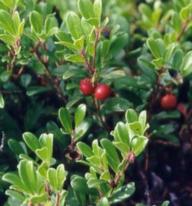

Common name: Bearberry,
Foxberry, and Kinnikinic
Genus: Arctostaphylos
Species: uva-ursi
Parts used:

Bearberry is a low growing evergreen. It has a stem that rises 2-8" off the ground and is covered in a thick bark and fine silky hairs. On the stem are many oval-shaped, leathery leaves that are _" to 1" long. The flowers have five petals and are pale pink or white. The petals are only _" long and are curled around the narrow center. They bloom anywhere between March and June. The fruit is a red berry 3/8" in diameter. Bearberry gets its name because bears like to feast on these berries.
Bearberry is commonly found in dry, non-nutrient soils such as sand, soils on rock outcrops and shallow soils. This plant ranges from northern California to Alaska, east from Oregon and Washington to the mountains of west Montana, and from there, south to New Mexico. Other areas of the world include Greenland, Iceland, and northern Eurasia. Bearberry is plentiful in the wild.
Since bearberry is a low growing plant it can stay out of the wind chill. It's fine silky hairs also help to keep it warm. Leathery leaves are also an adaptation to the cold of the tundra.
Bearberry is a very useful plant. All parts of it can be used in some way. The fruit can be eaten and cooked with other foods. The roots can be made into a tea that can treat a constant cough or slow down menstrual bleeding. A tea from the stem is used to prevent miscarriage and to speed up a women's recovery after childbirth. The leaves can be added to tobacco or used as a substitute for it. A tea made from the leaves can be drunk to treat kidney or bladder problems.
Ben P. 2001
Bibliography:
"Bearberry"
http://www.rook.org/earl/bwca/nature/shrubs/artouvaursi.html
(11/30/00)
"Manitoba
Agriculture and Food"
http://www.gov.mb.ca/agriculture/crops/medici…q00s03.htm
(12/2/00)
"Shrub Fact
Sheet"
http://plant-materials.nrcs.usda.gov:90/pmc/shrubs/aruv.html
(12/2/00)